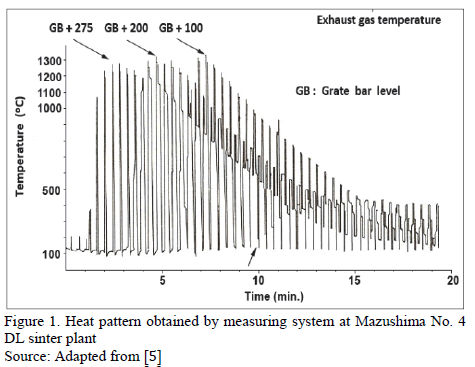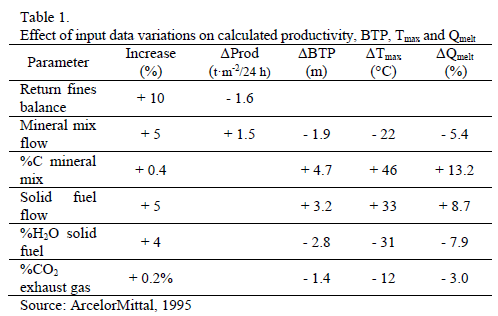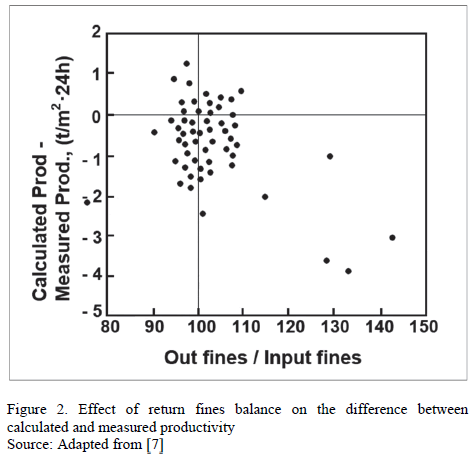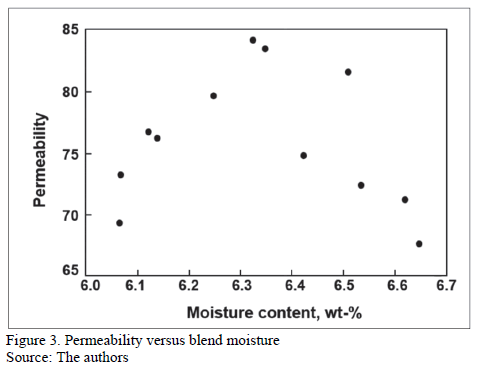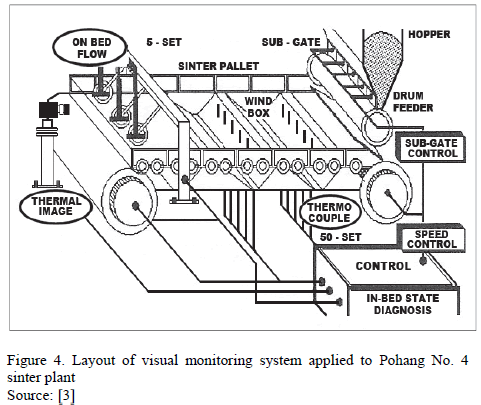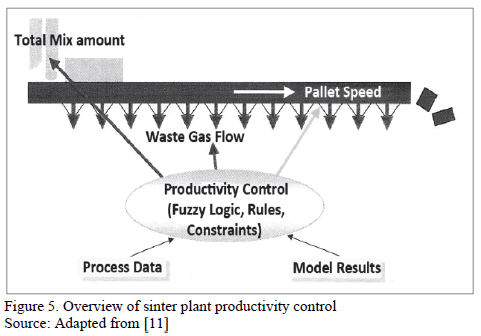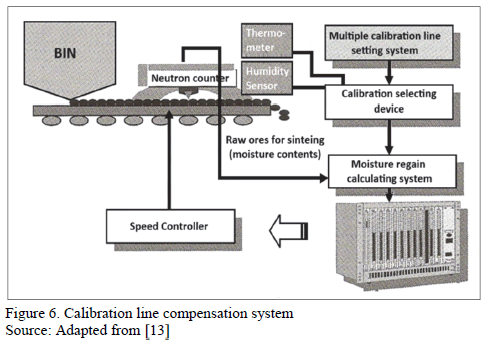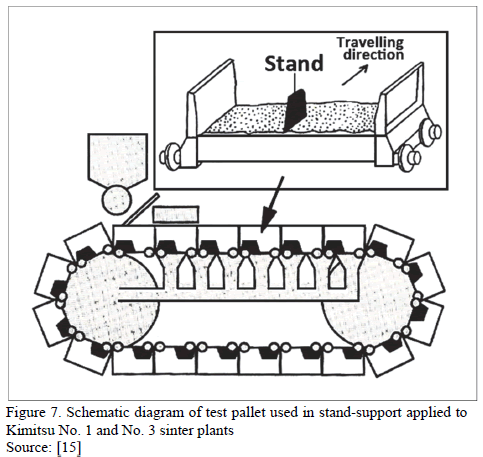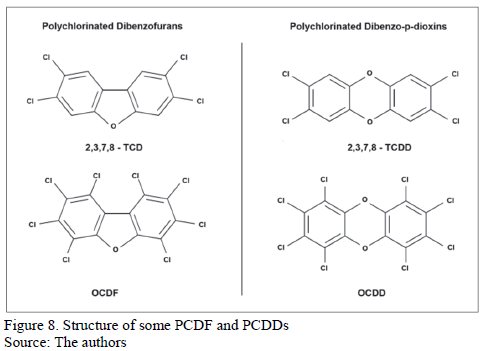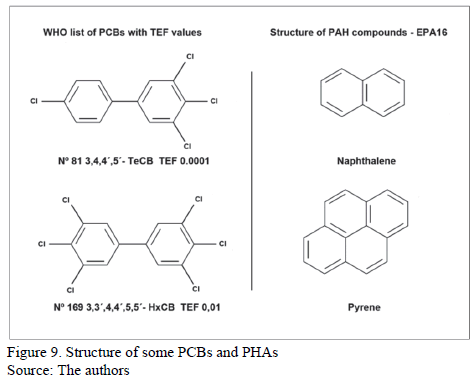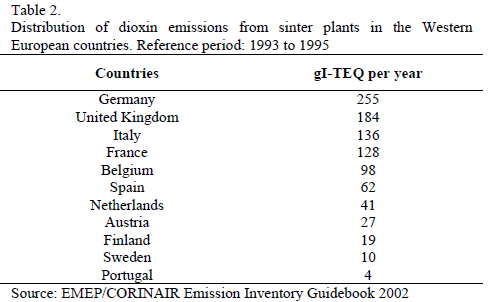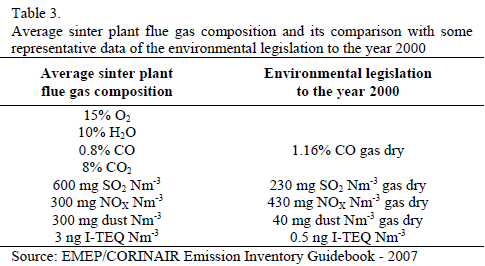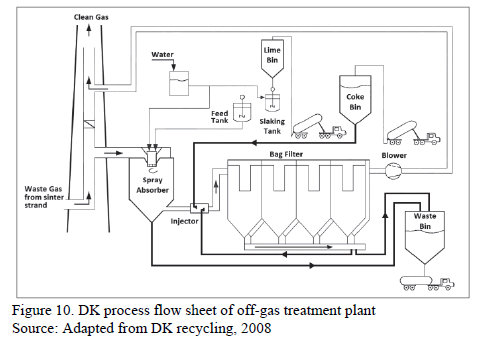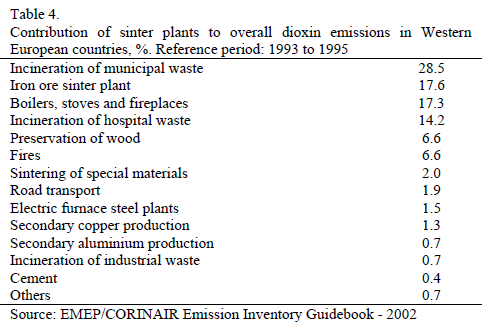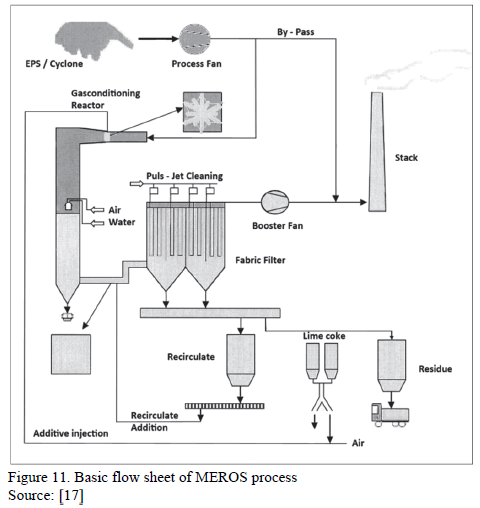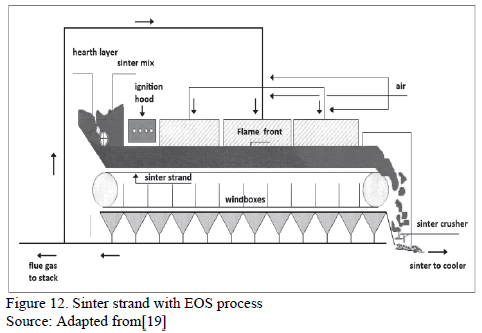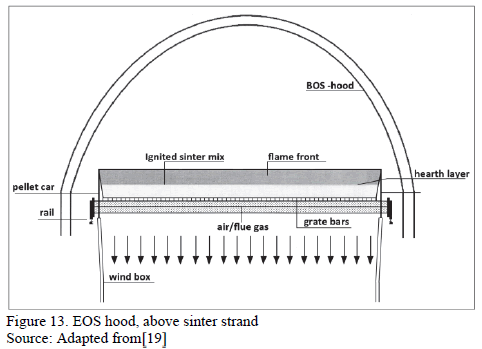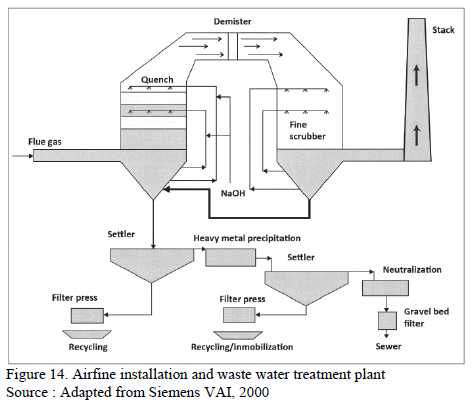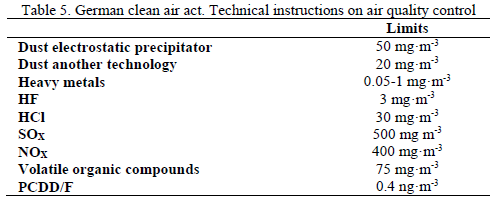Servicios Personalizados
Revista
Articulo
Indicadores
-
 Citado por SciELO
Citado por SciELO -
 Accesos
Accesos
Links relacionados
-
 Citado por Google
Citado por Google -
 Similares en
SciELO
Similares en
SciELO -
 Similares en Google
Similares en Google
Compartir
DYNA
versión impresa ISSN 0012-7353
Dyna rev.fac.nac.minas vol.82 no.190 Medellín mar./abr. 2015
https://doi.org/10.15446/dyna.v82n190.44054
DOI: http://dx.doi.org/10.15446/dyna.v82n190.44054
Iron ore sintering. Part 3: Automatic and control systems
Sinterización de minerales de hierro. Parte 3: Sistemas automáticos y de control
Alejandro Cores a, Luis Felipe Verdeja b, Serafín Ferreira c, Íñigo Ruiz-Bustinza d, Javier Mochón e, José Ignacio Robla f & Carmen González Gasca g
a Centro Nacional de Investigaciones Metalúrgicas CSIC-CENIM, Madrid, Spain. alcores@cenim.csic.es
b Escuela Técnica Superior de Ingenieros de Minas, Oviedo, Spain. lfv@uniovi.es
c Centro Nacional de Investigaciones Metalúrgicas CSIC-CENIM, Madrid, Spain. serafin@cenim.csic.es
d Centro Nacional de Investigaciones Metalúrgicas CSIC-CENIM, Madrid, Spain. irbustinza@cenim.csic.es
e Centro Nacional de Investigaciones Metalúrgicas CSIC-CENIM, Madrid, Spain. jmochon@cenim.csic.es
f Centro Nacional de Investigaciones Metalúrgicas CSIC-CENIM, Madrid, Spain. jrobla@cenim.csic.es
g Universidad Europea - Laureate International Universities, Madrid, Spain mcarmen.gonzalez@uem.es
Received: June 18th, 2014. Received in revised form: July 23th, 2014. Accepted: July 25th, 2014
This work is licensed under a Creative Commons Attribution-NonCommercial-NoDerivatives 4.0 International License.
Abstract
The sintering process involves a large number of parameters, more than 500, each of which exerts a greater or lesser influence and needs to be controlled, within the possible limits, in order to optimise productivity, process stability, and standardise the composition and quality of the sinter produced. To comply with environmental legislation, a pollution control system must monitor the particle matter and gases generated and emitted into the atmosphere by the sinter plant. Automation and control systems are vital tools to assist plant operators in the monitoring of each stage of the sinter production process.
Keywords: Sintering, Automatic and control systems, Environment, Dioxins.
Resumen
El proceso de sinterización implica un gran número de parámetros, más de quinientos, cada uno de los cuales ejerce una mayor o menor influencia y necesita ser controlado, dentro de los límites posibles, con el fin de optimizar la productividad, la estabilidad del proceso, y la composición y la calidad de la sinterizado producido. Para cumplir con la legislación ambiental, un sistema de control de la contaminación debe monitorizar la composición de las partículas y los gases generados en la planta de sinterización y emitidos a la atmósfera. Los sistemas de automatización y control son herramientas vitales para ayudar a los operadores de la planta en el seguimiento de cada etapa del proceso de producción de sinterizado.
Palabras clave: Sinterización, Sistemas automáticos de control, Medio ambiente, Dioxinas
List of abbreviations
ATS Association Technique Sidèrurgie Française
BF blast furnace
BOF basic oxygen furnace
BSC British Steel Corporation
BTP burn through point
CIT cahiers d'informations techniques
COG coke oven gas
CRM Centre de Recherches Mètallurgiques, (Belgium)
CST Companhia Siderùrgica de Tubarão, (Brazil)
EFA entrained flow absorber
EOS emission optimized sintering
EPA Environmental Protection Agency
FDC/F 2,5 furandicarbaldehyde
IRSID Institut de Recherches de la Siderurgie Française
ISF intensified sifting feeder
ISIJ Iron and Steel Institute of Japan
ISS Iron and Steel Society, (USA)
I-TEF International toxicity equivalence factor
KSC Kawasaki Steel Corporation, (Japan)
MEROS Maximized emission reduction of sintering
NKK Nippon Kokan Keihin
NSC Nippon Steel Corporation
PAH polycyclic aromatic hydrocarbons
PCB polychlorinated biphenyls
PCDD Polychlorinated dibenzo-para-dioxin
PCDF Polychlorinated dibenzo furans
PM Particulate matter
POSCO Pohang Iron and Steel Company, (Korea)
ROGESA Roheisengesellschaft Saar, (G)
SP Sinter plant
VAI Voest-Alpine Industrieanlagenbau, GmbH, (A)
VDEh Verein Deutscher Eisenhüttenlente, (G)
VOC Volatile organic compounds
WHO World Health Organization
WISCO Wuhan Iron and Steel Company, (China)
WTP water treatment plant
XRD X-ray diffraction
X-ray CT X-ray computed tomography
1. Introduction
With the ultimate aim of raising productivity and lowering production costs, automation and control systems are needed to assure optimum and stable operation throughout the sintering process [1]. For this purpose, many ironworks have made efforts to understand in-bed phenomena and steer the process towards optimum operation. The main control techniques in sintering are charge density control to achieve uniform sintering across the width of the strand and pallet speed control to maintain optimum productivity and sinter quality [2].
It is also very important to control sinter plant gas emissions, which are produced in large volumes and contain a high number of pollutant substances with different degrees of toxicity. When an operating plant is modernised or a new plant is planned, special attention must be paid to the design of the gas scrubbing system in order to assure compliance with increasingly restrictive legislation on allowed emission limits for each pollutant substance.
2. Automation & Control Systems
The development of automation and control systems to reduce sinter production costs and stabilise the sintering process is currently one of the most important goals in the iron making industry. The following list includes some examples of the work that different companies are carrying out in this field [3]:
SECOS: Sintering Energy Control System (KSC)
OGS: Operation Guide System (SMI, KSC)
Sub-Gate Opening Control (KOBE, NKK, KSC)
New BRP Control on Strand Speed (NKK)
ADONIS: Artificial Dexterous Nimble System (NSC)
K-SACS: Kawasaki Sinter. Automatic Control (KSC)
Unmanned Operation System at Fukuyama (NKK).
Year by year, improvements are made to the sintering process in every industrial sinter plant thanks to the accumulated experience of plant operators and the evolution and progress in sintering know-how.
In its sinter plants at Jamshedpur (India), Tata Steel has progressively improved the sintering process over more than 40 years through the appropriate selection of raw materials and the improvement of hardware [4]. It has successively lowered the Al2O3 content from 5.0 to 1.9%, with the corresponding improvement in the RDI, which has dropped from 31 to 27%. It has lowered the MgO content in the flux from 2.7 to 1.6%, and changed the source of magnesia from the initial dolomite to dunite and then to pyroxenite. In the period 1966-1968 the proportion of sinter in the blast furnace burden was 25%. In the period 1989-1995 this proportion had risen to 65%.
In its No. 4 SP at Muzishima (Japan), Kawasaki Steel Corporation (KSC) has developed sensors that monitor heat pattern indices in the sinter bed [5]. These sensors allow more elaborate operation control, not only by evaluating operating conditions from the transition of permeability, quality, yield and other conventional time-series data, but also by more directly estimating changes in bed conditions and controlling the wind volume distribution and coke distribution in the bed. Fig. 1 shows an example of heat pattern measuring.
In 1992 Arcelor-Mittal, in collaboration with CRM, developed an expert system with Nexpert Object software and VAX VMS hardware which controls 200 operating parameters every 15 seconds [6]. The system was installed in the company's 516 m2 DL5 SP at Ougrée (Belgium), with a production of 9450 t sinter per day. As a result, it has been possible to reduce the number of cases of cooking on the strand, to lower the standard deviation of the FeO content, to improve the RDI, and to improve control of burn-through point (BTP) and temperature profile in the wind boxes.
In 1994 Arcelor-Mittal installed in its No. 3 SP at Fos-sur-Mer (France) a sinter strand control system based on analysis of the CO, CO2 and O2 content in the wind box exhaust gases, coupled with the staged heat balance model developed by IRSID [7]. The experience in the plant is reflected in Table 1, which indicates the variation in productivity, BTP, maximum flame front temperature (Tmax) and the fraction of melt (Qmelt) that forms in the bed at the maximum temperature, as a function of the variation of a series of parameters. The theoretical productivity depends mainly on the return fines balance and on the raw mix flow. Assessment of the difference between real and measured productivities shows that the effect of the return fines balance is well traced [7] (Fig. 2).
The calculated BTP depends on the flow and the chemical composition of the raw mix (through the C content in the mineral mix and the H2O content in the fuel) and the CO2 in the exhaust gas. Assessment of the difference between the calculated BTP and that resulting from temperature measurements under the grate shows variations on both sides of a mean deviation of the order of 1 to 2 m. An increase in this value constitutes a warming. The calculated Tmax reached at the flame front and the Qmax depend on heat inputs and requirements connected with the chemical composition of the raw mix.
British Steel Corporation (BSC) has a 336 m2 SP installed at Redcar (United Kingdom) with a production of 3.5 million tons per year. In 1994 improvements to the plant were begun [8]. A VAX 4000/500 was selected as the central computer for logging data from 4500 signals with two MicroVAX 3100 Model 80s to act as auxiliary machines to drive terminals and printers.
Use of the computer has improved the determination of the optimum raw mix moisture following a sinter bed change. By being able to constantly monitor operating data, it has been possible to calculate permeability on a continuous basis, based on gas and air flows into the ignition furnace. In Fig. 3 the optimum moisture can be easily observed. It is also possible to see the known strong influence of moisture on permeability.
To measure the FeO content in the sinter, a belt coil system has been placed around the product conveyor belt [8]. Improved FeO control allows a coke saving of 1 kg t-1 of sinter. It is also possible to improve process control and achieve greater strand use efficiency by measuring and controlling the BTP, where the maximum temperature occurs. A BTP model has been installed on the new plant computer to calculate and detect the burn-through point along the sinter strand by measuring the under-strand temperature for the last eight wind boxes. The model calculates a proposed strand speed to bring the actual BTP into line with a user-specified setting, and this is notified to the operators in control of the strand. When strand speed has been controlled using this model, strand utilisation has increased by about 1%.
To increase production in Tobata No. 3 SP at Yamata (Japan), NSC extended the length of the machine from 90 to 120 m, maintaining the 4 m pallet width. Since 1990 successive improvements have been introduced in the plant [9]. The intensified sifting feeder (ISF) designed for NSC was installed to reduce the charge density and alleviate the avalanche of raw mix as charge onto the pallet. This ensured uniform sintering of the sinter cake and improved the yield and shatter index (SI) of the sinter cake. ISF technology is widely applied on sintering machines both within and outside NSC [10]. Energy consumption in Tobata No. 3 SP has been reduced by installing a NSC-developed surface combustion burner that mixed the fuel gas (COG) and air at the inlet of the premix chamber. The completely premixed gas is ejected through the network of porous plates (80 to 90% porosity) at the premix chamber outlet and is rapidly burned to form a high temperature flame. Exhaust gas recycling equipment has also been implemented, consisting of recirculation blowers installed at the charge and discharge end of the sinter strand. The discharge-end high temperature gas from the sinter bed is drawn from the first half of the strand after the ignition to use its sensible heat as sintering energy. The charge-end gas is drawn from the middle of the strand. Sintering energy consumption has been reduced by about 100 MJ per ton of sinter.
Pohang Iron and Steel Company, in its No. 4 SP at Pohang (Korea), has 25 wind boxes and produces 13500 t sinter per day, which accounts for 82% of the ferric material in its blast furnace burden. An integrated visual monitoring and guide system has been in operation in this plant since 1995, and consists of fifty thermocouples, 5 on-bed flow meters, a thermal imaging device and a sub-gate opening control system [3]. The thermocouples are situated below wind boxes 15 to 25, and the 5 flow meters are on the bed of box 6. Fig. 4 shows the layout of the developed system. This system helps the operator to maintain the process in optimum and stable conditions. Visualisation of the strand state gives the operator very good information on pallet speed, charging density and fuel content. As a result, fluctuations in the off-gas temperature under the sinter pallet decrease significantly after automatic control of the sub-gate opening. This results in a lower return fine production rate and higher product yield. Moreover, the emitted dust content through the stack is greatly reduced by maintaining a stable in-bed condition during sintering.
In the year 2000, Wuhan Iron and Steel Company (WISCO) in China, in collaboration with Voest-Alpine Industrieanlagenbau (VAI) of Austria, installed in its No. 1 SP, integrated by four strands of 126 m2 each, a model that calculates 700 values at two levels of automation and a set of process optimisation modules [11]. Despite the great complexity of the process parameters, the main objectives are to improve output by 5%, to reduce coke consumption by more than 2%, and to assure more than 99.5% system availability. The level 1 model includes all the main data from different sources, such as the analysis of raw materials and sinters.
This data is presented to the operator in the most efficient way, preferably in graphic format. The level 2 model provides closed-loop control of the process (without human interaction). Several groups of setpoints are calculated: raw mix flow, material ratios, water addition, and sinter strand speed to control the BTP. The models calculate the setpoints at any time and simultaneously verify the applicability of these setpoints. If this is the case, the system can switch from level 1 to level 2. If level 2 control is not possible for any reason, control is again taken over by the level 1 system. Fig. 5 shows the set of parameters used to control output.
When it is not possible to regulate the strand speed in an ideal way, speed variations may be expected to cause unstable operation. To control the process it is necessary to assure complete sintering of the mix before reaching the end of the strand, and guarantee that the cooking point is as close as possible to the end of the strand in order to obtain the maximum output.
In its Gwangyang plant (Korea), POSCO has installed an on-line measuring system to check the moisture content in the iron ores and coke sent to the drum mixer hoppers [12]. The system is based on a fast neutron source.
When the fast neutrons collide with hydrogen atoms in the mineral water, they lose energy in proportion to the number of hydrogen atoms, and the moisture content may be determined using a sensor that detects the slow neutrons resulting from the collision (Fig. 6). The system is calibrated to take into account variations in the ambient temperature and humidity over the year.
Research has been carried out on sinter cake structure samples from commercial sinter plants and experimental pots using X-ray computed tomography (X-ray CT) [13]. The sinter cake contains non-sintered, sintered, oversintered and pore areas. An increase in the alumina content in the raw mix causes impaired productivity by preventing the coalescence of pores. The presence of metallic iron impaired productivity through the formation of a dense sinter cake. Intensifying segregation, by means of an ISF, enhanced productivity by decreasing the unsintered portion. Magnetic levitation of sinter cake improved productivity by preventing shrinkage.
Companhia Siderùrgica de Tubarão (CST) has modernised its sinter plant at Vitoria (Brazil) in collaboration with VAI [14]. The pallet width has been increased from 5.0 to 5.5 m, making it the widest sintering machine in the world. This measure increased the sintering area from 440 to 484 m2, leading to a rise in productivity from 37.0 to 38.9 t m-2 per day and an increase in production from 16280 to 18800 t per day, without any loss of sinter quality. Other improvements have also been obtained, including reductions in electrical energy consumption, ignition gas, coke, burnt lime and production costs.
A new sintering technique called "stand support sintering", to support the sinter cake with bars or plates attached to pallets, has been developed [15]. This technique has been applied to the No. 1 and No. 3 SPs at Kimitsu works (Japan), improving shrinkage, porosity, reducibility and productivity rates (Fig. 7).
At Kakogawa sinter plant in Japan, research has been carried out to determine the optimal granulation moisture value of sinter raw materials, testing the effect of added moisture for six types of ore adjusted to the same particle size distributions [16]. The optimal moisture value to achieve maximum packed bed permeability was determined for each ore. From the results obtained, an optimal moisture value determination method was adopted, based on the hypothesis that the moisture would not affect the optimal moisture for the mix materials, and a weighted average was determined for the optimal moisture for the mix proportions of each brand of ore and auxiliary materials. The application of the optimal moisture allows the added moisture value to be reduced compared to the conventional method. The packed bed permeability in the sinter plant increased and productivity rose by 11 t h-1.
3. Environment
The importance of sintering plants lies not only in their ability to take advantage of the finest iron ore granulometries, but also their capacity to recycle waste products generated throughout the ironmaking industry without altering the required physical, chemical and mechanical properties of the sinter loaded into blast furnaces [17,18]. Gas emission volumes are high, of the order of 2·106 Nm3 h-1[18], and it is relevant to note that most sinter plants in developed countries, which years ago were located well away from built-up areas, are now surrounded by encroaching urban sprawl. Whereas before the 1990s environmental attention was focused on dust and SO2 emissions, in the final years of the 20th century and the start of the 21st century, concern shifted to NOX pollution, heavy metals (mercury, lead, chrome and cadmium) and hydrocarbons, especially dioxins [18] (Figs. 8 and 9).
The World Health Organisation (WHO) highlights the risks of polycyclic organic hydrocarbon emissions as potential carcinogenic substances, especially dioxins (polychlorinated dibenzo-para-dioxin (PCDD) and polychlorinated dibenzo furans (PCDF) or simply PCDD/F). However, not all 75 possible PCDD formulations or 135 PCDF formulations present the same health risk, and a toxicity parameter known as the international toxicity equivalence factor (I-TEF) has been introduced.
Furthermore, in order to express the toxicity of a particular gaseous emission composed of dioxins, polycyclic aromatic hydrocarbons (PAH) or polychlorinated biphenyls (PCB), the term equivalent toxicity, I-TEQ, has been proposed, which serves to represent all the compounds that form part of a sample, with their corresponding concentration, CX[18,20]:

Since the start of the 21st century, the monitoring and control of environmental dioxin emissions is a particularly sensitive issue in view of their harmful effects on health. In 1993, 95% of chlorinated gaseous pollutant emissions, 2.5 furandicarbaldehyde (FDC/F) from the ironmaking industry, came from sinter plants. In 1995, 17.6% of European dioxin emissions were produced by sintering [21] (Table 2). On the other hand, although there continues to be no agreement on a global standard, in most industrialised countries increasingly stringent restrictions are being set on pollutant product emissions.
Table 3 shows gas composition values in a sintering process without the introduction of corrective technologies and the limitations that have been imposed by environmental legislation [21].
3.1. Alternatives for Emission Control
Table 3 shows the composition of fumes emitted by sinter plants in the last decade of the 20th century and the high rates of harmful products they contained. The measures that can be adopted to reduce emissions are as follows:
- "Primary measures", based on careful selection of the quality of the raw materials used in the process;
- "Secondary measures", reducing pollutant emissions by end-of-pipe means involving mechanical, physical or chemical treatment of the solid or gaseous wastes generated;
- "Tertiary processes", using potentially polluting ironmaking by-products as raw materials, thus concentrating the treatment of hazardous ironmaking waste in one or several facilities.
One objection to primary measures lies in the need to recycle oxidised products with the greatest potential to form dioxins, PCBs or PAHs in sintering fumes. Similarly, one of the disadvantages of secondary processes lies in the large amount of fumes to be treated, with a negative influence on gas scrubbing-decontamination costs.
The Lucchini Severstal plant in Servola (Trieste-Italy) has carried out retrofitting measures to limit the particulate matter (PM) emissions in all the plant facilities (coals, iron ores and raw materials stockyards, coke oven, sinter plant, blast furnace and casting machine) [22], in accordance with the legislation of the Environmental Protection Agency (EPA). As a result it has continuously decreased the number of days a year in the 2004-2009 period, for which the permitted thresholds by EPA to PM emissions were exceeded.
The tertiary process has been developed by the German company DK Recycling and Roheisen GmbH to process 450,000 tons per year of different dusts and sludges (BF sludge, BOF dust, sand blasting dust, cupola dust, mill scale, Cu sludge and P sludge) using a sinter plant to transform the waste oxides into a product that meets the requirements for processing in a blast furnace [23].
The amount of waste oxides generated per ton of steel produced is 40 kg. The DK process causes problems with dioxin and furan emissions. In order to overcome these problems an off-gas treatment plant has been installed in the sinter plant downstream of the existing electrostatic precipitator (Fig. 10). The plant is installed so that off-gas is taken from the stack right after the main suction fan and piped into the spray absorber where an atomiser treats it with a very fine mist of milk lime. The reaction product gypsum falls into a cone at the base of the absorber from where it is pneumatically transported to the waste bin. Between the spray absorber and the bag house, lignite coke is injected into the gas stream.
The coke and other reaction products are captured in the bag filter. All measurements of the clean gas leaving the bag house have been below 0.4 ng I-TEM Nm-3.
The formation of chlorinated gaseous pollutants between 250 and 350 °C, by means of partial combustion catalysed by metals, is one of the most real options in what is known as "novo synthesis" [20,24-27].

Due to the fact that sinter plants and urban waste incinerators are the major source of dioxin emissions (Table 4), attempts have been made to transfer experience in dioxin removal from urban waste incinerators to sintering. Nevertheless, there are notable technological differences between dioxin generation in incinerating plants and in sinter strands [21]. There is no unanimous agreement about where dioxins are generated and their possible correlation with other volatile organic compounds (VOCs). Nevertheless, there is a conviction that the maximum dioxin concentration is reached in the wind boxes located at the end of the grate, before the sinter is tipped into the shredder. On the other hand, the maximum VOC concentration is found in the wind boxes located towards the centre of the sinter strand [21,24]. However, all such considerations are heavily dependent upon the chemical characteristics and the proportions of the raw materials used in sintering. If novo synthesis is catalysed by metals, in processes that involve a greater presence of metals, these may influence the location of the wind boxes where the maximum concentration is reached [23,25-26].
Sintering fumes are treated with hydrogenated products such as ammonia and urea to reduce dioxin and nitrogen oxide emissions. Treatment with ammonia is carried out in wind boxes along the entire sinter strip, while the addition of urea, which is more efficient, takes place in the mixing drum [20,24-26].
3.2. Industrial treatment processes
Since the end of the last century, when secondary processes to reduce pollutant emissions from sinter plants were gradually starting to be implemented, the following observations may be made:
- The treatments applied were initially simple in order to reduce dust and SO2 contents in exhaust fumes.
- More complex technologies were subsequently applied, both in wet and dry treatment processes, incorporating solid waste and wastewater treatment installations in the process.
- The estimated cost of meeting more restrictive environmental regulations (clean air) can account for up to 35% of the plant construction cost [27].
3.2.1. WETFINE system
The WETFINE technology developed by VAI to reduce dust, alkaline chloride, SOX and dioxin contents, consists of a flexible modular system adaptable to smoke decontamination not only in sinter plants but also in pelletisers, urban waste incinerators and industrial furnaces. Gas scrubbing is achieved by a mixed system: wet wash and electrostatic discharges. The treatment capacity of the modules ranges between 70,000 and 300,000 Nm3 h-1. Nevertheless, this treatment system is not capable of reducing dioxin emission levels below 0.4 ng I-TEQ Nm-3, as required by legislation. For this reason it has been necessary to resort to the addition of urea and the modification of some plant operating parameters [24].
3.2.2. MEROS process
In the maximised emission reduction of sintering (MEROS) process, developed by Siemens-VAI, dust, acid gases, hazardous metals and organic compounds present in the sintering gases are eliminated with high efficiency rates. In 2007 the first installation started operating at Linz (Austria), with a gas treatment capacity of 1,000,000 Nm3 h-1. One of the most outstanding characteristics of MEROS is that it fulfils current environmental regulations and may work within the restrictions that will foreseeably be set in the future [17,19] (Fig. 11).
3.2.3 EOS system
The great volume of fumes and the low concentration of elements to be decontaminated has always been one of the problems of sinter plants. The fundamental objective of the emission optimised sintering (EOS) system is to reduce the volume of the fumes to be decontaminated (potentially achieving a reduction of up to 50%) by placing a hood above the sinter grate which is fed with both clean air and recycled air from the wind boxes[17,19] (Figs. 12 and 13).
3.2.4 AIRFINE system
The installations of this process developed by VAI, consist of two scrubbers in series: the first rapidly cools the gases (quench scrubber) while the second, which operates with parallel water and gas currents, eliminates the finest dust particles and dioxins (fine scrubber). Fig. 14.
The water used in the cooling and treatment of the sintering gases is sent to a water treatment plant (WTP). Similarly, parts of the solids collected in the WTP are recycled to the sintering plant. The key to AIRFINE consists in the special design of a wet gas scrubbing system with the use of dual spray nozzles (liquid/gas) which achieve the atomisation of water particles in the fumes, obtaining sizes in the region of 50 mm [28,30].
The Siemens VAI selective waste gas recirculation system was installed in March 2005 at the No. 5 SP of VAI in Linz (Austria). In 2009 it was installed at the No. 1 SP of Dragon Steel Corporation (DSC) in Taichung (Taiwan). With this system the content of heavy metals, dioxins, SOX and NOX in the waste gas is reduced [31].
3.2.5 EFA process
The entrained flow absorber process, developed by the company Paul Wurth, belongs to the alternative secondary "end of pipe" process which maintains the electrostatic precipitator and adds an injection process with an EFA operating with hydrated lime and activated lignite coke [32]. It has been used in the ROGESA No. 2 SP at Dillinger (Germany), since 2005, and complies with German legislation, which has also been adopted by other countries (Table 5).
This process has now been installed in three other German sinter plants.
4 Conclusions
Sinter is the main burden material for some blast furnaces, whose correct operation depends largely on the quality of the sinter used. Sinter plants throughout the world work with a wide variety of mineral mixes which are characterised in great depth in terms of granulometry and chemical and mineral composition. Plant operating parameters must be adaptable to allow the introduction of low iron-content ores in the mineral mix to replace high iron-content ores that are usually included in the processed mix but are withdrawn for reasons such as stock depletion or excessive price.
Sinter plants are in constant evolution as a consequence of the practical operating experience acquired over the years, with improved techniques and systems to control the high number of parameters that intervene in the process. Plants have to adapt and incorporate gas scrubbing systems to comply with increasingly restrictive legislation on the limitation of toxic pollutant emissions into the atmosphere.
References
[1] Cores, A., Verdeja, L.F., Ferreira, S., Ruiz-Bustinza, Í. and Mochón, J., Iron ore sintering Part 1. Theory and practice of the sintering process, DYNA, 80 (180), pp. 152-171, 2013. [ Links ]
[2] Mochón, J., Cores, A., Ruiz-Bustinza, Í., Verdeja, L.F., Robla, J.I. and García-Carcedo, F., Iron ore sintering Part 2. Quality indices and productivity, DYNA, 81 (183), pp. 168-177, 2014. http://dx.doi.org/10.15446/dyna.v81n183.41568 [ Links ]
[3] Cho, B.K. and Lee, S.H., Proc. 2nd Int. Cong. on Sci. and Tech. Ironmaking. ISS Ironmaking Conf. Proc., 57, pp. 1291-1298, 1998. [ Links ]
[4] Yadav, U.S., Das, B.K. and Baijal, A.D., Proc. 3rd Int. Conf. on Sci. and Tech. of Ironmaking, VDEh, Düsseldorf, Germany, pp.138-143, 2003. [ Links ]
[5] Kurihara, J., Fukuda, A., Tanaka, S. and Nigo, S., ISS Ironmaking Conf. Proc., 41, pp. 80-89, 1982. [ Links ]
[6] Depaye, P., Mathonet, Ch., Vanderheyden, B. and Manassis, E., Proc. 3rd European Cokemaking and Ironmaking Cong., Gent, Belgium, Vol. 1. Ed. CRM, Liège, Belgium, pp. 193-201, 1996. [ Links ]
[7] Marlière, E., Dulcy, C., Huguet, C. and Leblanc, O., Pro. 3rd European Cokemaking and Ironmaking Cong., Gent, Belgium, Vol. 1 Ed. CRM, Liège, Belgium, pp. 202-208, 1996. [ Links ]
[8] Fisher, D.J., and Coulston, B.: ISS Ironmaking Conf. Proc., 56, pp. 383-389, 1997. [ Links ]
[9] Gushima, A., Sakuragi, J. and Ikehara, S., Proc. 3rd European Cokemaking and Ironmaking Cong., Gent, Belgium, Vol. 1. Ed. CRM, Liège, Belgium, pp. 184-192, 1996. [ Links ]
[10] Honorato, E.P. and Seshadri, V., Granulometric optimisation of raw materials for ISF continuous segregation system in Usiminas' sintering plants, Ironmaking Steelmaking, 35 (6), pp. 405-415, 2008. http://dx.doi.org/10.1179/174328108X318374 [ Links ]
[11] Wendong, S., Bettinger, D., Straka, G. and Stohl, K., Sinter plant automation on a new level !, Rev. Met. Paris, 98 (11), pp. 999-1008, 2001. http://dx.doi.org/10.1051/metal:2001141. [ Links ]
[12] Lee, K., Proc. on Iron and Steel Tech. Conf., Indianapolis, IN, USA. Assoc for Iron and Steel Tech., Warrendale, PA, USA, 1, pp. 199-206, 2007. [ Links ]
[13] Nakano, N., Kawaguchi, T., Kasama, S. and Hosotani, Y., Proc. 2nd Int. Cong. on Sci. and Tech. Ironmaking. ISS Ironmaking Conf. Proc., 57, pp. 1283-1290, 1998. [ Links ]
[14] Harano ,E.L.M., Vidal, J.A.N., da Silva, M.R., Pammer, O., Ram, H. and Gould, L., ISS Ironmaking Conf. Proc., 58, pp. 533-543, 1999. [ Links ]
[15] Higuchi, K., Kawaguchi, T., Kobayashi, M., Hosotani, Y., Nakamura, K., Iwamoto, K. and Fujimoto, M., ISIJ Int., 40, pp. 1188-1194, 2000. http://dx.doi.org/10.2355/isijinternational.40.1188 [ Links ]
[16] Matsumura, T., Maki, T., Amano, S., Sakamato, M. and Iwasaki, N., Effect of moisture absorption behavior on optimal granulation moisture value of sinter raw material, ISIJ Int., 49 (5), pp. 618-624, 2009. http://dx.doi.org/10.2355/isijinternational.49.618 [ Links ]
[17] Vanderheyden, I.B., Marlière, M., Zwaan, F. and Neuschütz, D., Control of pollutants during sintering operation, [on line]. European Commission Technical Steel Research. EUR 20373 EN, 151 P., 2002, Available at: http://bookshop.europa.eu/en/control-of-pollutants-during-sintering-operation-pbKINA20373/ [ Links ]
[18] Fisher, R., Garcia, F., Alaiz, E. and Pietruck, R., Effects of operational factors on the formation of toxic organic micropollutants in EAF steelmaking, [om line]. European Commission Technical Steel Research. EUR 21429 EN, pp. 151 P., 2005. Available at: http://bookshop.europa.eu/en/effects-of-operational-factors-on-the-formation-of-toxic-organic-micropollutants-in-eaf-steelmaking-pbKINA21432/ [ Links ]
[19] Alexander, F., Robert, N. and Tobias, P., Proc. on Iron and Steel Tech. Conf., Indianapolis, IN, USA. Association for Iron and Steel Tech., Warrendale, PA, USA, 1, pp. 215-223, 2007. [ Links ]
[20] Southern, S., Edmundson, J. and Hakimian, M., Proc. 4th European Cokemaking and Ironmaking Cong., Paris, France, ATS, Paris, 1, pp. 118-125, 2000. [ Links ]
[21] Perez, J., Espinel, J., Ocampo A. and Londono, C., Dioxinas en procesos de incineración de desechos, DYNA, 134, pp. 65-75, 2001. [ Links ]
[22] Boscolo, M. and Padoano, E., Monitoring of particulate emissions to assess the outcomes of retrofitting measures at an ironmaking plant, ISIJ Int., 51 (9) pp. 1553-1560, 2011. http://dx.doi.org/10.2355/isijinternational.51.1553 [ Links ]
[23] Moore, C.M., Deike R. and Hillman, C., Proc. 3rd Int. Conf. on Sci. and Tech. of Ironmaking, VDEh, Düsseldorf, Germany, pp. 578-581, 2003. [ Links ]
[24] Tan, P. and Neuschütz, D., Metall. Mater. Trans. B, 2004, 35B, 983-991. DOI: http://dx.doi.org/10.1007/s11663-004-0092-7 [ Links ]
[25] Boscolo, M. and Padoano, E., Investigations into dioxin emissions at Italian iron ore sintering plant, Ironmaking Steelmaking, 35 (5), pp. 338-342, 2008. http://dx.doi.org/10.1179/174328108X287739 [ Links ]
[26] Kasai, E., Aono, T., Tomita, Y., Takasaki, M., Shiraishi, N. and Kitano, S., Macroscopic Behaviors of Dioxins in the Iron Ore Sintering Plants, ISIJ Int., 41 (2), pp. 86-92. 001, http://dx.doi.org/10.2355/isijinternational.41.86 [ Links ]
[27] Lüngen, H.B. and Theobald, W., Proc. 2nd European Ironmaking Congr., Glasgow, United Kingdom. The Institute of Metals, London, United Kingdom, pp. 275-288, 1991. [ Links ]
[28] Leuwerink, T. and Van der Panne, A., Proc. 4th European Cokemaking and Ironmaking Cong., Paris, France, ATS, Paris, 1, pp. 374-379, 2000. [ Links ]
[29] Hofstadler, K., Muraer, F., Steiner, D. and Gebert, W., WETFINE, a new gas cleaning technology for sinter and pellet plants, Rev. Mètall. CIT, 98 (10), 2001, pp. 825-831. http://dx.doi.org/10.1051/metal:2001129 [ Links ]
[30] Leuwerink, T. and Van der Panne, A.: Stahl Eisen, 121, pp. 21-34, 2001- [ Links ]
[31] Reidetschläger, J., Stiasny, H., Hötzinger, S., Aichinger, C. and Fulgencio, A., Stahl Eisen, 132, pp. 25-30, 2012, [ Links ]
[32] Hartin, W. and Reufer, F., Iron Steel Tech., 8 (4), pp. 81-86, 2011. [ Links ]
A. Cores, is PhD in Chemical Sciences from the Universidad Complutense de Madrid, Spain and scientific researcher "ad honorem" at the Spanish National Research Council (CSIC)
L.F. Verdeja, is PhD in Chemical Sciences from the Universidad de Oviedo, Spain, member of the European Chemist Registration Board. European Communities Chemistry Council (ECCC), Chairman of Steelmaking at the University of Oviedo
S. Ferreira, is PhD in Chemical Sciences from the Universidad Complutense de Madrid, Spain, and scientific researcher "ad honorem" at the Spanish National Research Council (CSIC)
Í. Ruiz-Bustinza, is Metallurgical and Mining Engineer from the School of Mines of Madrid (ETSIM - UPM), Spain, PhD from the University of Oviedo, Spain. Responsible for European RFCS Projects at CENIM - CSIC (Spain)
J. Mochón, is PhD in Physical Sciences from the University Hispalense of Sevilla, Spain, university professor and scientific researcher "ad honorem" at the Spanish National Research Council (CSIC)
J.I. Robla, is PhD in Chemical Sciences from the Universidad Complutense de Madrid, Spain and scientific researcher at the Spanish National Research Council (CSIC), Spain. Lead Researcher of the Group "Processes, Materials and Energy in the Ecological and Sustainable Metallurgy"
C.González-Gasca has a PhD in Mining Engineering from the School of Mines of Madrid (ETSIM - UPM), Spain, Coordinator of the Doctoral Program of the Centre of Excellence for Research, Intelligent Systems and Renewable Energies at the Universidad Europea - Laureate International Universities (Spain).













